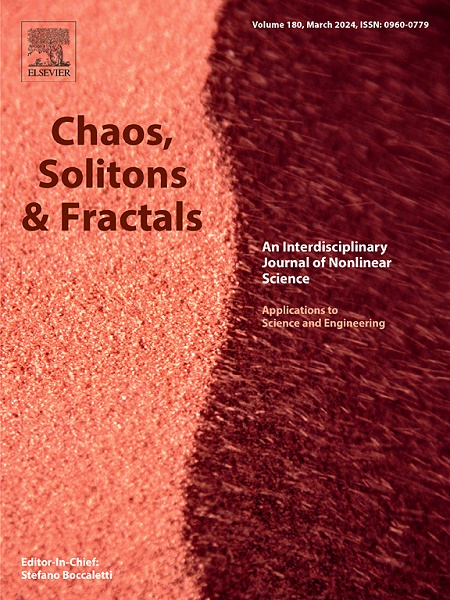Chaotic intermittency as a random telegraphic signal
IF 5.6
1区 数学
Q1 MATHEMATICS, INTERDISCIPLINARY APPLICATIONS
引用次数: 0
Abstract
A wide range of processes can be characterized by a random telegraphic signal, which is essentially a time-dependent signal that oscillates randomly between two distinct values. Meanwhile, the concept of chaotic intermittency holds significant relevance across various fields, including physics, engineering, and medicine, among others. This paper aims to establish a connection between these two topics to deepen our understanding of chaotic intermittency. Specifically, we explore how the probabilities associated with waiting or sojourn times in random telegraphic signals can be linked to the probability density of laminar lengths, as determined through a novel theoretical framework of chaotic intermittency. To validate our theoretical findings, we conduct a series of numerical experiments focused on three different types of intermittencies: type I, type II, and type III. We demonstrate that the correlation between random telegraphic signals and chaotic intermittency offers several advantages. In particular, this formulation enables the evaluation of the probability that the system remains in either a laminar or chaotic phase. Therefore, this technique facilitates the comparison between analytical and numerical approaches, and we conclude that there is a very close alignment between both approaches.
作为随机电报信号的混沌间歇性
广泛的过程可以用随机电报信号来表征,它本质上是一个随时间变化的信号,在两个不同的值之间随机振荡。同时,混沌间歇的概念在包括物理、工程和医学等各个领域都具有重要的相关性。本文旨在建立这两个主题之间的联系,以加深我们对混沌间歇性的理解。具体来说,我们探索了随机电报信号中与等待或逗留时间相关的概率如何与层流长度的概率密度联系起来,这是通过混沌间歇性的新理论框架确定的。为了验证我们的理论发现,我们对三种不同类型的间歇进行了一系列数值实验:ⅰ型、ⅱ型和ⅲ型。我们证明了随机电报信号和混沌间歇性之间的相关性提供了几个优点。特别地,这个公式能够评估系统保持在层流或混沌阶段的概率。因此,这种技术促进了分析方法和数值方法之间的比较,我们得出结论,这两种方法之间存在非常密切的一致性。
本文章由计算机程序翻译,如有差异,请以英文原文为准。
求助全文
约1分钟内获得全文
求助全文
来源期刊

Chaos Solitons & Fractals
物理-数学跨学科应用
CiteScore
13.20
自引率
10.30%
发文量
1087
审稿时长
9 months
期刊介绍:
Chaos, Solitons & Fractals strives to establish itself as a premier journal in the interdisciplinary realm of Nonlinear Science, Non-equilibrium, and Complex Phenomena. It welcomes submissions covering a broad spectrum of topics within this field, including dynamics, non-equilibrium processes in physics, chemistry, and geophysics, complex matter and networks, mathematical models, computational biology, applications to quantum and mesoscopic phenomena, fluctuations and random processes, self-organization, and social phenomena.
 求助内容:
求助内容: 应助结果提醒方式:
应助结果提醒方式:


